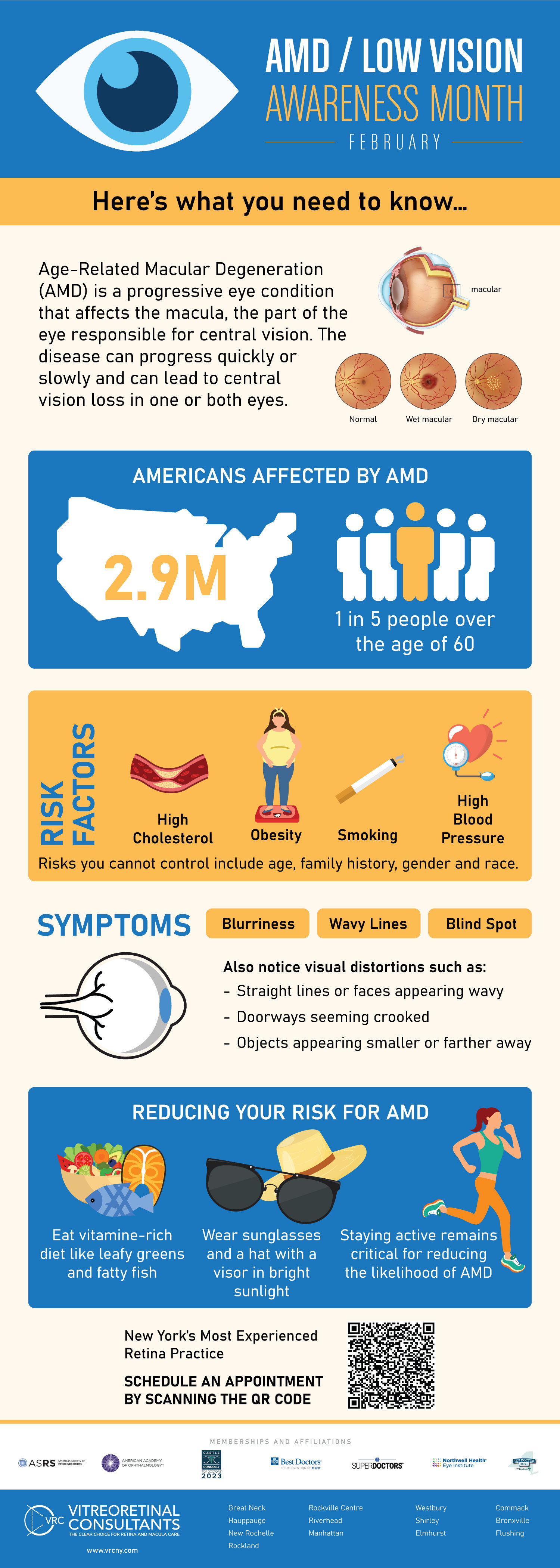Understanding AMD: Types, Awareness, and Early Intervention
Age-Related Macular Degeneration (AMD), often abbreviated as ARMD, is a medical condition that warrants our attention, especially as we age. It affects older adults and can lead to vision loss, making it essential to shed light on this condition.
At Vitreoretinal Consultants of NY (VRCNY), we are dedicated to keeping you informed about AMD and its implications for your eye health.
What is AMD?
AMD stands for age-related macular degeneration, a condition that primarily affects older adults. It results from the deterioration of the macula, which is the central part of the retina responsible for sharp focus and color vision. AMD is a leading cause of vision impairment among individuals aged 60 and above.
Understanding the nuances of AMD is crucial, as there are two main types: dry and wet:
- Dry AMD: This is the more common form, accounting for approximately 90% of AMD cases. Dry AMD occurs when tiny protein deposits, known as drusen, accumulate in the macula. In its early stages, vision may remain unchanged, but as it progresses, central vision can deteriorate. Treatment consists of vitamin therapy with a formulation called AREDS 2. Everyone starts as dry, but some will progress to wet. An advanced form of dry is called GA which stands for geographic atrophy, where patches of thinning retina occur. There is treatment for this form of the disease.
- Wet AMD: Although less prevalent at approximately 10% of cases, wet AMD is considered more advanced and severe. It develops when abnormal blood vessels form beneath the retina's macular region, leading to fluid accumulation and bleeding. Wet AMD invariably impacts central vision. There is treatment for this form of the disease.
AMD Awareness Matters. Raising awareness about AMD is vital for several reasons:
- Prevalence: With AMD being a significant cause of vision loss among older adults, awareness ensures that individuals are vigilant about their eye health as they age.
- Early Detection: Early intervention is the key to managing AMD effectively. Awareness prompts regular eye exams, allowing for timely diagnosis and treatment.
- Risk Factors: Knowledge about AMD's risk factors empowers individuals to make lifestyle choices that can reduce their chances of developing the condition. Factors such as age, family history, smoking, high blood pressure, and dietary habits all play a role.
Navigating AMD Risks: Unveiling the Link with Smoking
While some AMD risk factors like aging and genetics are beyond control, addressing controllable factors can significantly mitigate risks and enhance overall health. Smoking stands out as a primary controllable risk factor for AMD, encompassing various tobacco types and exposure scenarios, including secondhand smoke.
- Current smokers face up to a fourfold increased risk of AMD compared to non-smokers, with potential onset occurring up to a decade earlier and progression often proving less responsive to treatment.
- Intriguingly, a genetic correlation exists, particularly with mutations in the HTRA1 gene, where smokers with specific variants are at a staggering 20 times higher risk of AMD development, constituting a substantial portion of AMD cases.
- The effectiveness of antioxidants, essential nutrients that counteract oxidative stress from free radicals, can be compromised by smoking. Excessive free radicals are associated with chronic conditions like diabetes and cancer.
- The tar found in cigarette smoke may contribute to the formation of drusen, yellowish deposits of cellular waste beneath the retina, often indicative of early-stage age-related macular degeneration (AMD).
- With over 4,500 toxic chemicals such as arsenic and formaldehyde, tobacco smoke poses a significant risk to vision-related components including the retina, macula, and lens. These toxins travel through the bloodstream, potentially causing damage to delicate tissues and blood vessels, including the microvasculature within the retina.
- Moreover, smoking can lead to decreased oxygen levels reaching the choroid, a crucial vascular layer behind the eye, which affects its interaction with the retinal pigment epithelium (RPE), essential for light absorption and the reduction of harmful reflections.
- Activation of the complement cascade, a component of the immune system strongly linked to AMD development, can be triggered by smoking.
- Additionally, smoking may impact the effectiveness of specific AMD treatments, such as laser therapies.
Understanding AMD: Grasping the Dry and Wet Divide
- Age-related macular degeneration (AMD), the leading cause of blindness among older adults, presents in two primary forms: dry and wet.
- Dry AMD, prevalent in the majority of cases, typically manifests with gradual vision changes such as blurriness, while about 10% progress to the more severe wet AMD.
- Wet AMD, marked by abnormal blood vessel growth under the retina, poses a heightened risk of vision loss due to fluid leakage into the macula, potentially leading to permanent impairment.
- Managing AMD: Embracing a Holistic Lifestyle Approach
- While no cure exists for AMD, adopting a healthy lifestyle can significantly mitigate symptoms and slow progression.
- Daily habits such as consuming eye-nourishing nutrients like vitamin C, maintaining a healthy weight and blood pressure, wearing sunglasses outdoors, and crucially, abstaining from smoking, can help manage AMD symptoms.
- Treatment Landscape: Exploring Options for Wet AMD
- Treatment options for wet AMD include surgical interventions like photocoagulation and photodynamic therapy, alongside anti-VEGF injections such as Avastin, Lucentis, and Eylea.
- Despite these interventions, in advanced cases, progressive vision loss may persist, underscoring the critical need for early detection and intervention.
AMD Risk Awareness: Prioritizing Regular Eye Exams
- Early diagnosis through routine eye exams is paramount in mitigating AMD-related vision loss, especially considering prevalent risk factors like age, smoking, obesity, hypertension, and family history.
- Regular eye check-ups, at least annually, empower timely detection and intervention, serving as the frontline defense against AMD progression and vision impairment.
By intertwining insights on smoking's impact with holistic AMD management strategies and the significance of proactive eye care, we equip individuals with the knowledge and tools to navigate their AMD journey with clarity and resilience.
The VRCNY Commitment:
At Vitreoretinal Consultants of NY, we recognize the importance of AMD awareness and early intervention. Our team of dedicated specialists is equipped with the expertise and advanced technology to detect and manage AMD at its earliest stages. Your vision is our priority, and we are here to support you every step of the way.
Understanding AMD, its types, and the significance of awareness is the first step towards preserving your vision.
At VRCNY, we urge you to prioritize your eye health and stay informed. Regular eye exams and early detection are your allies in the fight against AMD. Let's work together to safeguard your sight!
For more information, check out these blogs and resources:
- https://www.fda.gov/tobacco-products/health-effects-tobacco-use/how-smokin g-can-contribute-vision-loss-and-blindness
- https://www.nei.nih.gov/learn-about-eye-health/outreach-resources/vision-reha bilitation-resources
- https://www.vrcny.com/retinal-care/age-related-macular-degeneration-amd
- https://www.vrcny.com/education-center/dry-macular-degeneration-and-geogr
- aphic-atrophy-risk-factors-prevention-and-treatment
- https://www.vrcny.com/retinal-care/age-related-macular-degeneration-amd
- https://www.island-retina.com/low-vision-aid



